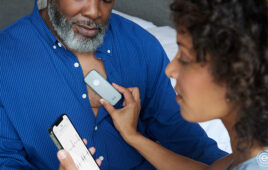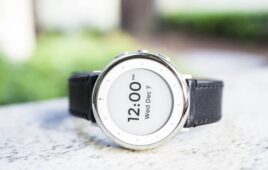More than 50 percent of clinically significant cardiac arrhythmias are recorded after the typical 48-hour monitoring period typical for Holter monitors. These legacy monitors rely on the patient to activate the device when they experience symptoms, but nearly 90 percent of patients cannot recognize themselves as being at high risk prior to an actual heart attack. Without a continuous 24-hour capability, doctors often miss the critical minutes before the patient activates the device. 1 According to Stuart Long, CEO of InfoBionic, a leading digital health company, new developments in remote cardiac monitoring are enabling cardiologists to see a complete readout of cardiac data in near real time – as its happening – while shaving valuable days off of the time-to-diagnosis.
About 610,000 people die of heart disease in the U.S. every year and 47 percent of sudden cardiac deaths occur outside a hospital. 2 Tests such as electrocardiograms enable a cardiologist to look at a patient’s heart activity at rest and at one point in time. But abnormal heart rhythms and cardiac symptoms may come and go most often without the patient even knowing it. The main purpose of an event monitor is to record the heart rate and rhythm during a symptom (“event”). They work only when a person interacts with the device to log the symptom they feel. The doctor may recommend an event monitor when symptoms are infrequent – less than daily.
A Holter monitor provides a more complete picture of heart activity but requires the patient to return the unit to the physician’s office after a period of days and wait for results while the cardiologist sends the data to a third-party diagnostic for analysis.3 In a scenario where the monitor diagnosis eventually shows evidence that an arrhythmia has occurred, the delay puts the patient at risk.
Thanks to advances in data storage, transmission and machine learning, a new generation of remote cardiac monitors enables 24/7 monitoring, combined with sophisticated data analysis to help physicians cut through large amounts of data. Cardiologists can now monitor a patient’s every heartbeat over extended periods and identify potentially dangerous arrhythmias as they happen — all via convenient HIPAA-compliant access through any internet connected device such as a PC or mobile device.
Now doctors can fit a patient with a device and get immediate and current data over a secure cell phone connection. If a patient calls experiencing symptoms, the cardiologist can quickly see the patient’s up-to-the-minute data on a cell phone, table or PC – and make a critical cardiac arrhythmia diagnosis instantly. This is a dramatic alternative to having a patient return with a legacy cardiac monitor, then uploading the data to a third-party provider. “What we developed is a non-emergency, virtual telemetry-type station – that doctors can hold in their hand,“ described Stuart Long, CEO of InfoBionic. “The ability to interpret and diagnose a cardiac event as it happens and get help for the patient immediately is a clear win for both the physician and more importantly for the patient.”
Long points out that, as one of the next generation of non-invasive, remote cardiac monitors now being placed in service, the MoMe® Kardia monitoring system from InfoBionic effectively aids cardiologists by providing:
- Anytime access to 24-hour patient data – cardiologists can verify possible cardiac events, map symptoms to actual arrhythmias, and help provide assistance to patients that require intervention.
- Full disclosure data in a variety of formats, with sophisticated display algorithms — allowing doctors to quickly sort through vast reams of data and identify and focus on important cardiac events.
- Expanded data over much longer periods, which may capture smaller events that may otherwise go unrecorded, diagnosing faster and more accurately.
- Elimination of an expensive middleman – the traditional heart monitoring device service – by offering complete ownership of their remote cardiac monitoring service line.
Devices like the MoMe® Kardia threaten to thoroughly disrupt the cardiac monitoring process—from faster, more accurate diagnosis to vastly improved efficiency within the practice.
- Barrett, P., et al. “Comparison of 24 Hour Holter Monitoring Versus 14 Day Novel Adhesive Patch Electrocardiographic Monitoring.” American Journal of Medicine, 2014.
- Staff writer. “Heart Disease Facts.” Centers for Disease Control. 2018. Web.
- Staff writer. “Heart Attack – Diagnosis and Treatment.” Mayo Clinic. Web.




